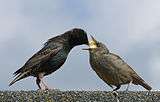Microbivory
Microbivory (adj. microbivorous, microbivore[1]) is a feeding behavior consisting of eating microbes (especially bacteria) practiced by animals of the mesofauna, microfauna and meiofauna.[2][3][4]
Microbivorous animals include some soil nematodes,[5][6][7] springtails or flies such as Drosophila sharpi. A well known example of microbivorous nematodes is the model roundworm Caenorhabditis elegans which is maintained in culture in labs on agar plates, fed with the 'OP50' Escherichia coli strain of bacteria.
In food webs of ecosystems, microbivores can be distinguished from detritivores, generally thought playing the roles of decomposers, as they don't consume decaying dead matter but only living microorganisms.
Use of term in robotics
There is also an use of the term 'microbivore' to qualify the concept of robots autonomously finding their energy in the production of bacteria. Robert Freitas has also proposed microbivore robots that would attack pathogens in the manner of white blood cells.[8]
See also
References
- Effects of microbivore species composition and basal resource enrichment on trophic-level biomasses in an experimental microbial-based soil food web. J Mikola, Oecologia, 1998
- Rates of metazoan meiofaunal microbivory: a review. PA Montagna, Vie et Milieu, 1995
- Energetics of detritivory and microbivory in soil in theory and practice. DC Coleman, Food Webs, 1996
- Radioisotope technique to quantify in situ microbivory by meiofauna in sediments. PA Montagna, Handbook of methods in aquatic microbial ecology …, 1993
- Life cycle of the microbivorous Antarctic Dry Valley nematode Scottnema lindsayae (Timm 1971). A Overhoff, DW Freckman, RA Virginia - Polar Biology, 1993
- Organic and inorganic nitrogenous losses by microbivorous nematodes in soil. RV Anderson, WD Gould, LE Woods, C Cambardella… - Oikos, 1983
- Uncoupling of carbon and nitrogen mineralization: role of microbivorous nematodes. MC Savin, JH Görres, DA Neher, JA Amador - Soil Biology and Biochemistry, 2001
- Robert A. Freitas Jr., Microbivores: Artificial Mechanical Phagocytes using Digest and Discharge Protocol, self-published, 2001
External links
| Look up microbivorous in Wiktionary, the free dictionary. |
| Look up microbivore in Wiktionary, the free dictionary. |
